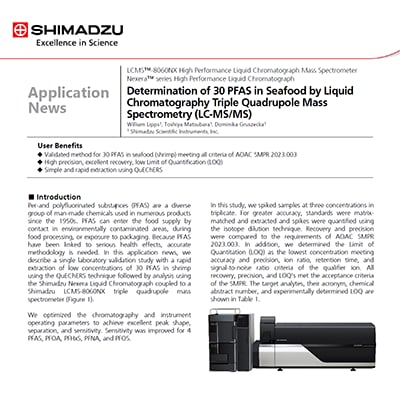PFAS in Food and Food Packaging
As our awareness of environmental and health concerns continues to grow, testing our food becomes increasingly important. Per- and polyfluoroalkyl substances (PFAS) were widely applied chemicals: they were used in packaging, as water and oil repellants, as well as fire-fighting coatings. Leaching from packaging materials and contaminating water sources, these persistent chemicals find their way into our food chain, raising concerns about long-term health effects. With growing evidence linking PFAS exposure to adverse health effects, testing for PFAS in our food is crucial in keeping us safe and healthy.
Shimadzu at AOAC International 2024
AOAC or Association of Official Analytical Collaboration is an international group of government, industry, and academic professionals dedicated to food safety and product integrity. This year, a big focus was the global response to PFAS contaminated food. Read here for a summary of our seminars and our posters for download.
Determination of 30 PFAS in Seafood by Liquid Chromatography Triple Quadrupole Mass Spectrometry (LC-MS/MS)
Per-and polyfluorinated substances (PFAS) are a diverse group of man-made chemicals used in numerous products since the 1950s. PFAS can enter the food supply by contact in environmentally contaminated areas, during food processing, or exposure to packaging. Because PFAS have been linked to serious health effects, accurate methodology is needed. In this application news, we describe a single laboratory validation study with a rapid extraction of low concentrations of 30 PFAS in shrimp using the QuEChERS technique followed by analysis using the Shimadzu Nexera Liquid Chromatograph coupled to a Shimadzu LCMS-8060NX triple quadrupole mass spectrometer.
Analysis of Per- and Polyfluoroalkyl Substances (PFAS) in Food Samples by LC-MS/MS
PFAS are pervasive chemicals that can leach into water supplies and soil, contaminating food supply and posing risks to human health. This poster examines a quantitative analysis method for forty PFAS compounds in foods using weak anion-exchange SPE cleanup and LCMS. A fifteen-minute runtime on a LCMS-8050 equipped with Nexera X3 UHPLC recovered PFAS from contaminated carrots within ± 30% of expected values. Purification results from the different cartridges tested was not significantly different, both resulting in analysis within range.
Are there PFAS in my water? A detailed look into bottled water.
The presence of Per- and Polyfluorinated Alkyl Substances (PFAS) in drinking water is being thoroughly
studied due to the persistence of these compounds in the environment and their potential health effects.
However, there is limited knowledge about the occurrence of these chemicals in bottled water, despite the
increasing concerns about PFAS in the food supply. This poster shows results from a fast and simple
direct injection method similar to EPA method 8237, using the Shimadzu LCMS-8050 to analyze seven
commercially available samples of bottled water for 24 PFAS. The results demonstrate that the
instrument’s performance exceeds the requirements in FDA draft method C-010.01 for other matrices,
including milk (which is the most similar to water), as well as the limits established by the EPA for drinking
water.
Analysis of PFAS compounds in Fish Tissue Using Offline Supercritical Fluid Extraction and LC-MS/MS
Polyfluoroalkyl substances (PFAS) are synthetic compounds that are found in a wide range of industrial and consumer products. Due to the strong nature of the carbon-fluorine bond, these compounds are resistant to degradation and have been found to accumulate in wildlife and fish, posing a significant health risk to humans. Current sample preparation techniques for PFAS analysis are laborious and not easily automated, In this study, supercritical fluid extraction was evaluated as an alternative sample preparation technique for the recovery of 18 PFAS compounds from fish tissue.
Detecting PFAS compounds in food packaging
Poly- and perfluoroalkyl substances (PFAS) – a.k.a. “forever chemicals” – are widely used in everyday applications, and there are approximately 5,000 known PFAS structures. This article presents a targeted approach for detecting and quantifying 24 PFAS commonly found in paper and board matrices. Using accelerated solvent extraction to extract PFAS, identification and quantification was done using high-performance liquid chromatography coupled with triple quadrupole mass spectrometry. Apparent recovery values were in the 84–94 % range, with method detection limit values in the 0.1–0.5 ng/g range.
Holy Cow - is that PFAS in my Milk?
The objective of this presentation is to develop a semi quantitative screening method for measuring PFAS residues in milk using MALDI TOF Axima Confidence and a quantitative confirmation method with LCMS/MS 8050









